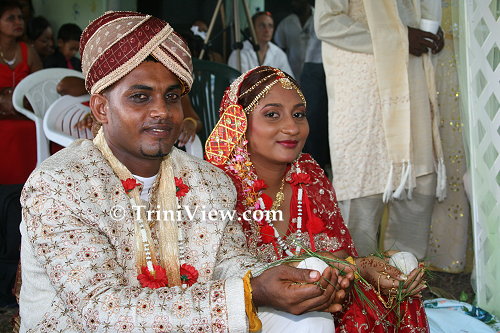 Hansraj Ramlal and Annesa Bissram
Hansraj Ramlal and Annesa Bissram
TriniView.com Reporters
Event Dates: October 03-05, 2008
Posted: November 18, 2008
Deep in the countryside of Trinidad, the tassa drums rang out as a large procession of mainly women walked along the semi-dark country road. It is Friday night in the village of Plum Mitan, not just an ordinary Friday night, but a big wedding is on Sunday and tonight is Maticoor night. It is the wedding of two Plum Mitan residents, Hansraj Ramlal and Annesa Bissram, and in the typical Hindu tradition, the wedding is an elaborate, religious and celebratory process that involves many people in the community.
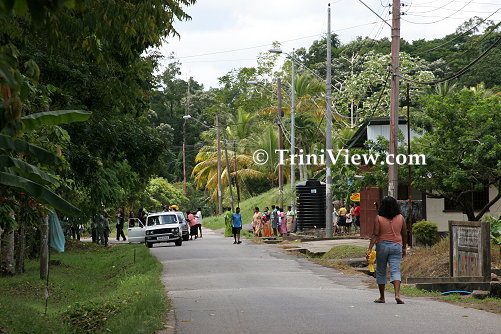 Plum Mitan Village
Plum Mitan Village
Our journey to Plum Mitan in East Trinidad was scenic, driving along the winding Plum Mitan Road through the lush forest, green scenery and a rice field before finally reaching the serene agricultural village. Just a stone's throw from the large Nariva wetland, Plum Mitan is a tight knit community where the majority of residents are East Indian.
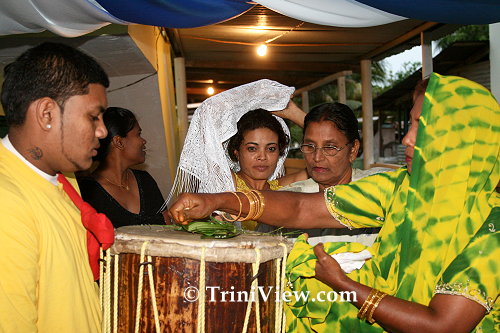 Purifying and blessing the tassa drums
Purifying and blessing the tassa drums
Friday night in the Hindu wedding tradition is the Maticoor Night, otherwise known as Ladies Night. Traditionally, Maticoor Night was reserved only for ladies, however, in contemporary times, males are allowed, although the bulk of the celebrants are usually women. At the residence of the dulaha (groom), it is evening and people have started to gather. There is a brief ritual to purify and bless the tassa drums, and then the tassa drums start to roll as the loud rhythms roll through the village.
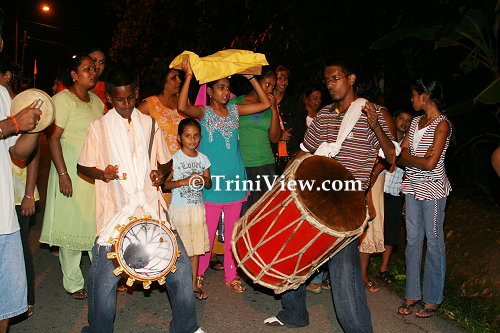 Unmarried girl with ceremonial tray at the procession
Unmarried girl with ceremonial tray at the procession
A group of married women prepare a ceremonial tray which will be carried by a young unmarried girl to the river followed by a large group of mostly women. At the small stream, they are met by a similar procession that came from the nearby dulahin's (bride) residence. Dirt is dug from the bank and put in a container to be carried back to the chowka (sacred space). The tassa drums grow louder as the two tassa groups meet and slowly ladies start to dance and gyrate on the otherwise lonely country road. The excitement and energy increase as more ladies start to dance in the center. After this excitement, the dulaha's procession goes back to the dulaha's residence, while the dulahin's procession returns to the dulahin's residence.
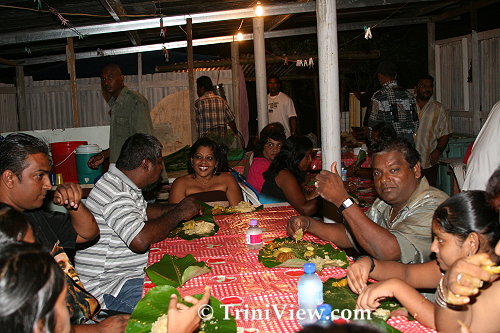 Family and friends at the table
Family and friends at the table
Saturday is Bhatwan or Farewell Night, and from early in the morning, there is a beehive of activity at both the Ramlal and Bissram residences. Both men and women prepare food, ranging from pepper choka, palmiste, bhaji, channa (chick peas), aloo, curry mango, homemade pepper sauce, vegetable salad, pumpkin, paratha roti (called 'buss-up-shot') and white rice. Food is a major aspect of the celebrations over all the days, and several huge pots cook on outside fires at the same time. Within this space, the efficiency and cooperation between the many people is a sight to behold, as each person has a role which fits smoothly in the broader scheme of things.
Night comes and many more people start to arrive at the residence as Chutney music blasts from speakers. People dance, interact and partake in the food that is shared out. The music stops as people gather around a specific sacred space where the aunt of the dulaha has arrived to parch the talwa, which involves a ritual of parching whole grain rice on a heated talwa. People come up and put money into a tray as the aunt parches the rice. The music starts again and the dancing resumes, as many look on in excitement. The same activity takes place in the dulahin's residence.
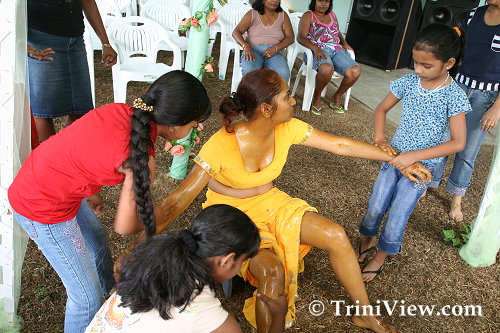 Bride being rubbed down by children
Bride being rubbed down by children
Sunday, the actual day of the wedding began with the Lawah which is the ceremonial rubdown with saffron. During this ceremony, both the bride and the groom were rubbed down by young children and relatives at their respective homes. This ceremony has also taken place on the first two days of the wedding.
After more food preparations took place on both sides of the family, it was time to dress the bride and groom for the special occasion.
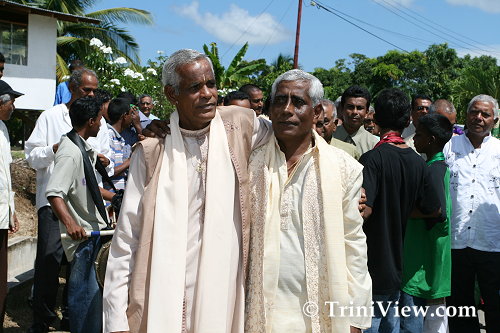 Meeting of the fathers
Meeting of the fathers
The ground wedding, which compared to the table wedding in Indian tradition, is a more elaborate ceremony. It begins with the meeting of the fathers of the bride and groom at the bride's residence. Living a short distance from the bride's home, the groom arrived in a decorated vehicle surrounded by friends and family who followed the wedding car by foot. Some arrived beforehand accompanied by the pulsating sounds of the tassa drums. In a symbolic move, the father of the bride embraces the father of the groom, and when this happens the two separate groups join as one with the drummers from both sides playing in sync with one another.
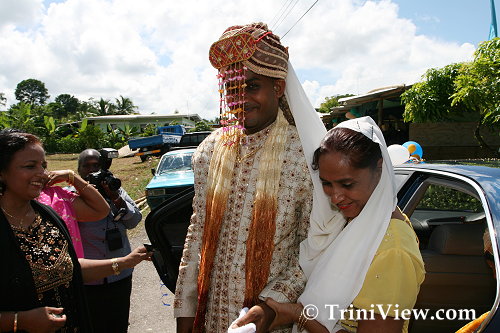 Groom is welcomed by the bride's family
Groom is welcomed by the bride's family
Before the groom exits the vehicle in which he has arrived, he receives blessings from womenfolk including the mother of the bride. It is only then that he enters the bride's residence.
After a brief ceremony performed by the pundit, his assistant and the fathers of the bride and groom, the groom finally joins the bride for the final ceremony, binding the pair together.
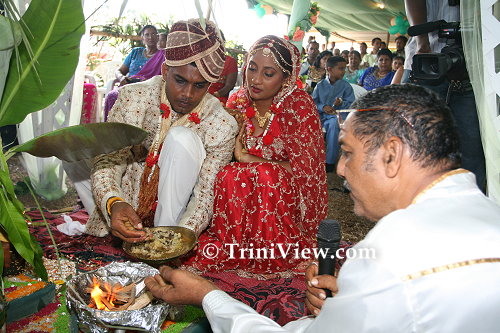 Wedding rites
Wedding rites
After the pundit has performed wedding rites, the bride and groom change from their traditional garments into white Western-type robes and proceed to the groom's home. Here they are greeted with the sounds of the tassa drums and the embracing welcome of the groom's family and friends, most of whom had been absent for the activities at the bride's residence.
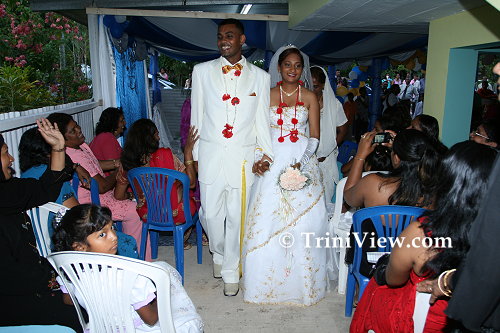 Bride and Groom greeted by groom's family
Bride and Groom greeted by groom's family
At the end, family and friends partake of the meal that was prepared earlier that day and dance the night away to the sounds of tassa and other music.
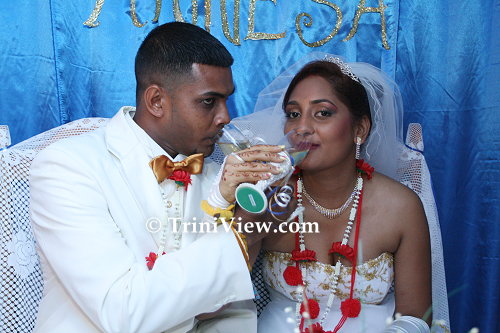 Bride and Groom toast
Bride and Groom toast
The bride and groom, visibly tired, stare lovingly into each other's eyes and raise a toast to being married while anticipating their future which has already begun.
Hindu Wedding in Plum Mitan in pictures:
www.triniview.com/gallery/main.php?g2_itemId=306183
Homepage | Special Events | Photo Gallery
|
|
